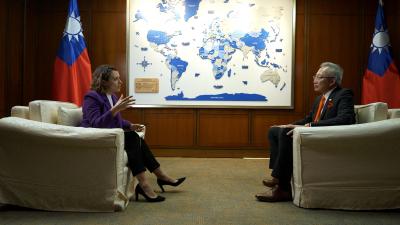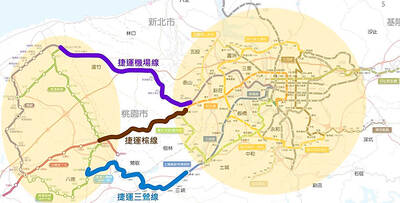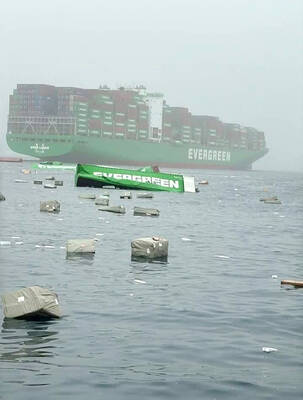Located on Ketagalan Boulevard, the Taipei Guest House has functioned as a major political site since it was established in 1901, and it is a great example of the fine European-style architecture built during the Japanese colonial era.
The building, which was built in the Renaissance style, originally served as the residence of the Japanese governor-general to Taiwan and as a venue for receptions for important guests. It later served as the venue for high-level talks on constitutional reform initiated by former president Lee Teng-hui (李登輝) and on the streamlining of the provincial government.
It was designated as a historic site in 1998 for its historical and political significance and is one of 142 historic sites in Taipei.

PHOTO COURTESY OF TAIPEI CITY’S CULTURAL AFFAIRS DEPARTMENT
Established 124 years ago, Taipei City is a relatively young metropolis. However, the city government is seeking to promote the rich historical legacy in the urban area by offering guided tours on municipal monuments scattered in 12 districts.
In celebration of annual World Monuments Day this month, Taipei City Archives, a commission under Taipei City’s Cultural Affairs Department, offered six guided tours of historic sites in Zhongzheng District (中正) last week, and will offer additional tours introducing historic sites in other districts every two months.
“Taipei City is full of stories, and we are hoping that the tours will help people understand more about the city’s history, and pay attention to the monuments that exist around them,” said Wu Chao-ming (吳昭明), a section chief of Taipei City Archives.

PHOTO COURTESY OF TAIPEI CITY’S CULTURAL AFFAIRS DEPARTMENT
The North Gate (北門), for example, is one of the most valuable historical and cultural assets in the city, Wu said. Located at the intersection of Zhongxiao W Road and Yenping S Road, the gate, also named Chengen Gate, is the best preserved part of the city wall, and the only one of the five city gates that was not torn down or reconstructed.
As the nation’s capital city, Taipei has served as a political center since Japanese colonial times. As a result, the political significance of many of the historic sites, including the 228 Memorial Museum, Taipei Zhongshan Hall (中山堂), the Presidential Office and Taipei Guest House (台北賓館), often outshines the architectural or cultural value of the monuments.
The Portrait of Water Buffalo, an art sculpture piece made of gypsum, is a masterpiece portraying scenery in rural Taiwan in the 1930s in the Taipei Zhongshan Hall collection. The piece is an example of a great part of a historic site often unnoticed by many visitors, Wu said.
In addition to introducing the municipal monuments from various perspectives, the guided tours also take visitors to “disappeared monuments” in the city, such as the original Taipei Confucius Temple (文廟) and the Guangong Temple (武廟).
The old Confucius Temple, originally in the current location of the Taipei First Girls’ High School, was built in 1884 to worship Confucius, but was demolished the next year by the Japanese.
The Guangong Temple, on the other hand, was built during the Qing Dynasty to worship Guangong, also known as God of War. The temple was demolished by the Japanese in 1934 and the site was used to construct the Taiwan High Court, which later became the current Taipei Judicial Building.
“It’s an interesting coincidence that the original Confucius Temple is now a prestigious school, and the Guangong Temple became a courthouse. The spirits of the two historic sites were passed on to the current sites in a wonderful way,” he said.
Michael Davidson, a 28-year-old English teacher from England and a member of an art group called Purplefoxleaf, was invited by the city government to lead a guided tour from the perspectives of an artist and a foreigner.
Davidson, who has been in Taipei for over three years, gave an introduction to historic sites with distinct architecture styles, such as the Chen Tien-lai Residence (陳天來故居), and focused on the European influence on the architecture of the monument.
The Chen Tien-lai Residence, established in 1920 in the Dadaocheng area, was the private residence of tea tycoon Chen Tien-lai. The three-story building offered an representative example of Chinese and European architecture styles, Davidson said.
The residence had served as a major gathering site for tea businessmen at that time, and witnessed the rise and decline of the tea industry and the Dadaocheng area in the early 20th century.
“Taipei is quite a modern city, and people may not be able to see there are also historic sites in the city,” he said, while urging the city government to step up efforts to preserve historic sites.
Teng Wen-tsung (鄧文宗), a division chief at the department, said district offices were responsible for the regular inspection of the 142 municipal monuments, and organizations in charge of the monuments need to maintain the sites. The department also allocates NT$20 million (US$620,000) annually for private organizations for the maintenance of the monuments.

“China is preparing to invade Taiwan,” Deputy Minister of Foreign Affairs Francois Wu (吳志中) said in an exclusive interview with British media channel Sky News for a special report titled, “Is Taiwan ready for a Chinese invasion?” the Ministry of Foreign Affairs said today in a statement. The 25-minute-long special report by Helen Ann-Smith released yesterday saw Sky News travel to Penghu, Taoyuan and Taipei to discuss the possibility of a Chinese invasion and how Taiwan is preparing for an attack. The film observed emergency response drills, interviewed baseball fans at the Taipei Dome on their views of US President

ECONOMIC BENEFITS: The imports from Belize would replace those from Honduras, whose shrimp exports have dropped 67 percent since cutting ties in 2023 Maintaining ties with Taiwan has economic benefits, Ministry of Foreign Affairs officials said yesterday, citing the approval of frozen whiteleg shrimp imports from Belize by the Food and Drug Administration (FDA) as an example. The FDA on Wednesday approved the tariff-free imports from Belize after the whiteleg shrimp passed the Systematic Inspection of Imported Food, which would continue to boost mutual trade, the ministry said. Taiwan’s annual consumption of whiteleg shrimps stands at 30,000 tonnes, far exceeding domestic production, the ministry said. Taiwan used to fill the gap by importing shrimps from Honduras, but purchases slumped after Tegucigalpa severed diplomatic ties with Taiwan

The Executive Yuan yesterday approved a southwestern extension of the Sanying MRT Line from New Taipei to Bade District (八德) in Taoyuan, with a goal of starting construction by late 2026. The 4.03-kilometer extension, featuring three new stations, will run from the current terminus at Yingtao Fude Station (LB12) in New Taipei City to Dannan Station (LB14), where it will connect with Taoyuan’s Green Line, New Taipei City Metro Corp said in a statement. This extension will follow the completion of core Sanying Line, a 14.29-kilometer medium-capacity system linking Tucheng (土城), Sansia (三峽)

CARGO LOSS: About 50 containers at the stern of the ‘Ever Lunar’ cargo ship went overboard, prompting the temporary closure of the port and disrupting operations Evergreen Marine Corp, Taiwan’s largest container shipper, yesterday said that all crew members aboard the Ever Lunar (長月) were safe after dozens of containers fell overboard off the coast of Peru the previous day. The incident occurred at 9:40am on Friday as the Ever Lunar was anchored and waiting to enter the Port of Callao when it suddenly experienced severe rolling, Evergreen said in a statement. The rolling, which caused the containers to fall, might have been caused by factors including a tsunami triggered by an earthquake in Russia, poor winter sea conditions in South America or a sudden influx of waves,